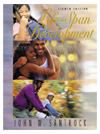 |  Life-Span Development, 8/e John W. Santrock,
University of Texas - Dallas
The Life-Span Development Perspective Introduction
Chapter Outline- THE LIFE-SPAN PERSPECTIVE
Why Study Life-Span Development The Historical Perspective Child Development Life-Span Development The Twentieth Century
Characteristics of the Life-Span Perspective
Development Is Lifelong Development Is Multidimensional Development Is Multidirectional Development Is Plastic Development Is Contextual Development Is Studied by a Number of Disciplines Development Involves Growth, Maintenance, and Regulatoin
Some Contemporary Concerns
Health and Well-Being Parenting and Education Sociocultural Contexts Social Policy
- THE NATURE OF DEVELOPMENT
Biological, Cognitive, and Socioemotional Processes Periods of Development Conceptions of Age Chronological Age Biological Age Psychological Age Social Age
Age and Happiness Developmental Issues Nature and Nurture Continuity and Discontinuity Stability and Change Evaluating Developmental Issues
- CAREERS IN LIFE-SPAN DEVELOPMENT
|
|



 2002 McGraw-Hill Higher Education
2002 McGraw-Hill Higher Education